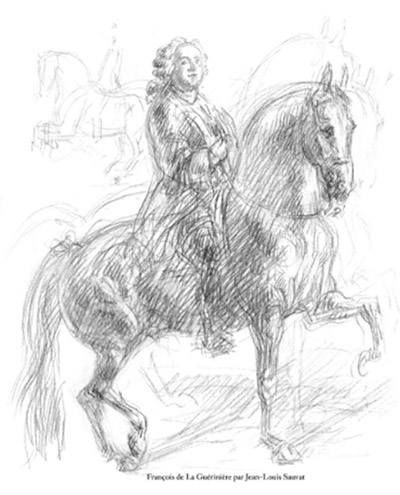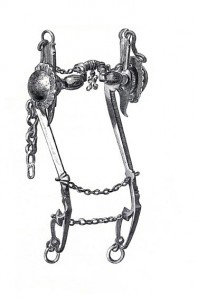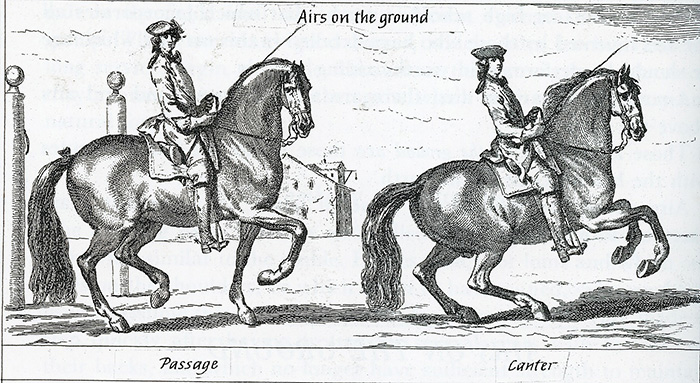When we study de la Guérinière’s Ecole de Cavalerie (published in 1731) for the first time, we find the crucial awareness of the developmental nature of classical riding – this really is what sets off dressage from other systematic ways of training a horse – the knowledge that the exercises have to be fitted to the physical development of the horse, and that the next step can only be taken when the horse is physically and mentally, ready for it. Interestingly, Guérinière was also aware of learned helplessness…
Here is the great master warning against pushing the horse too fast…
According to de la Guérinière:
“One often demands things that the horses are not capable of doing in a desire to push them too fast and teach them too much. These excessive demands make them hate exercise, strains and tires their sinews and tendons, upon whose elasticity suppleness depends and often these horses end up ruined when it is believed that they have been trained. Thus, no longer having the strength to fight back, they obey, but without grace or any spirit. There is still another reason that contributes to the formation of these faults: the horses are ridden at too early an age, and because the work demanded of them exceeds their strength and they are not developed enough to resist the degree of control they are subjected to before being trained, their loins are strained, their hocks are weakened, and they are permanently damaged. The proper age for training a horse is six, seven or eight, according to his native environment.”
He also had an interesting awareness of contact:
“Contact (apui) is the feel produced by the action of the bridle in the rider’s hand and, reciprocally, the action the rider’s hand produces on the bars of the horse’s mouth. There are horses with no contact, others with too much, and others who are fully on the bit. Those who have no contact fear the bit and cannot suffer its contact on their bars, which makes them fight the hand and toss their heads. The horses with too much contact lean heavily on the hand. The horses with the best mouths have a contact on the bit; without leaning on or fighting the hand, they have a consistent, light, and moderate contact. These three qualities of a good mouth in a horses correspond to those of a rider’s hand, which must be light, gentle and consistent.”
“To put a horse together (rassembler) is to shorten his gait or air in order to put him on his haunches. It is done by holding the forehand gently with the bridle hand and driving the haunches underneath the horse with the calves. It prepares the horse to be put between the hand and the legs.”
Reading this you are probably nodding your head in agreement – how true, how like today, until you take a look at the bit from the era!
The actual amount of contact likely to occur when mediated by a curb bit like this is perhaps very different from what we today might consider ‘contact’.
It would seem that work on the ground was valued. Thus back in 1731, de la Guérinière recorded:
“There used to be persons in charge of exercising the foals outside the breeding barn when they were still wild. They were called Cavalcdours de Bardelle. Those with the most patience, skill, energy and diligence were chosen; the perfection of these qualities was not as necessary for horses who were already being ridden. These people would accustom the young horses to allow someone to approach them in the stable, to pick up all four feet, to touch them, and to put on the bridle, saddle, crupper, girth, etc. They gave them assurance and made them gentle when mounted. They were never harsh or forceful, because at these times they would only use the most gentle methods that came to mind. Through this ingenious patience, they made a horse familiar with and a friend of man, maintained his vigour and courage, and made him understand and obey the first rules. If one were to imitate today the plan of these old connoisseurs, one would see fewer horses who are injured, ruined, one-sided, stiff and vicious.”
It would seem also that this eighteenth century maestro at least had some idea of that troubling first principle of the modern training scale, variously known as ‘relaxation’, or ‘submission’ or ‘losgelassenheit’. De la Guérinière seems to have a good handle on it, pointing to an earlier French master, de la Broue:
“De la Broue could not give a more exact description of a well-dressed horse than by saying that he is the one who shows suppleness, obedience and accuracy; the reason being that, if a horse’s body is not completely free and supple, he will not be able to respond to man’s demands with ease and with grace. Suppleness will always result in docility, because the horse will thus not have any problem in performing what is demanded of him.”
To achieve a ‘well-dressed’ horse required the ‘three essential qualities which comprise what is known as a well-adjusted horse.’
The first – suppleness – could only be developed in trot, because to achieve the first quality he must ‘vigorously work all the parts of his body’.
“It is through the trot, the most natural of all the gaits, that the horse is made light to the hand, without having his mouth spoiled, and stretches his limbs without risk of injury.”



